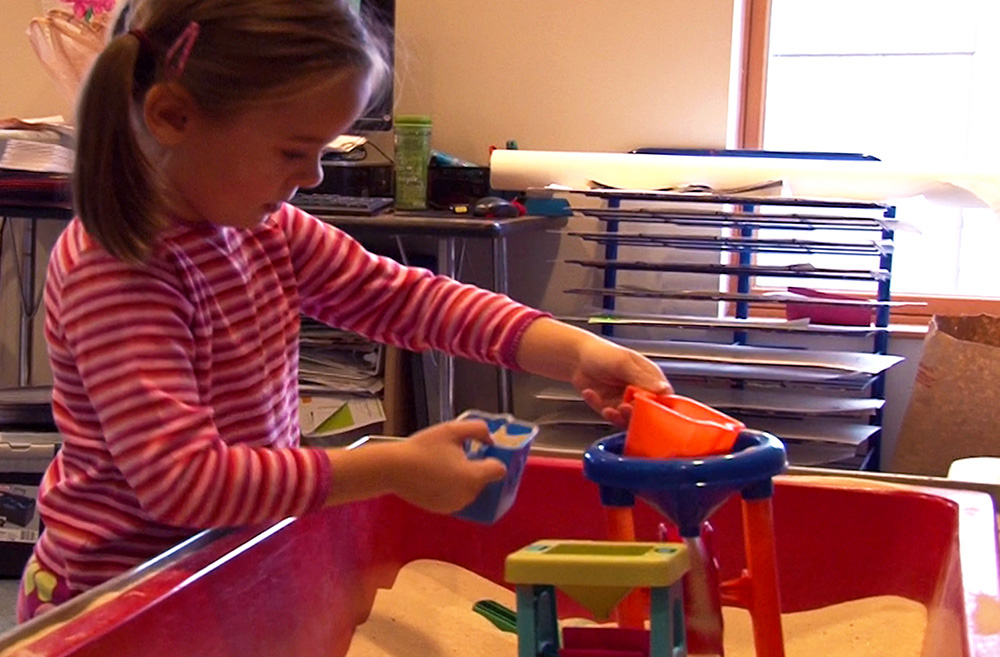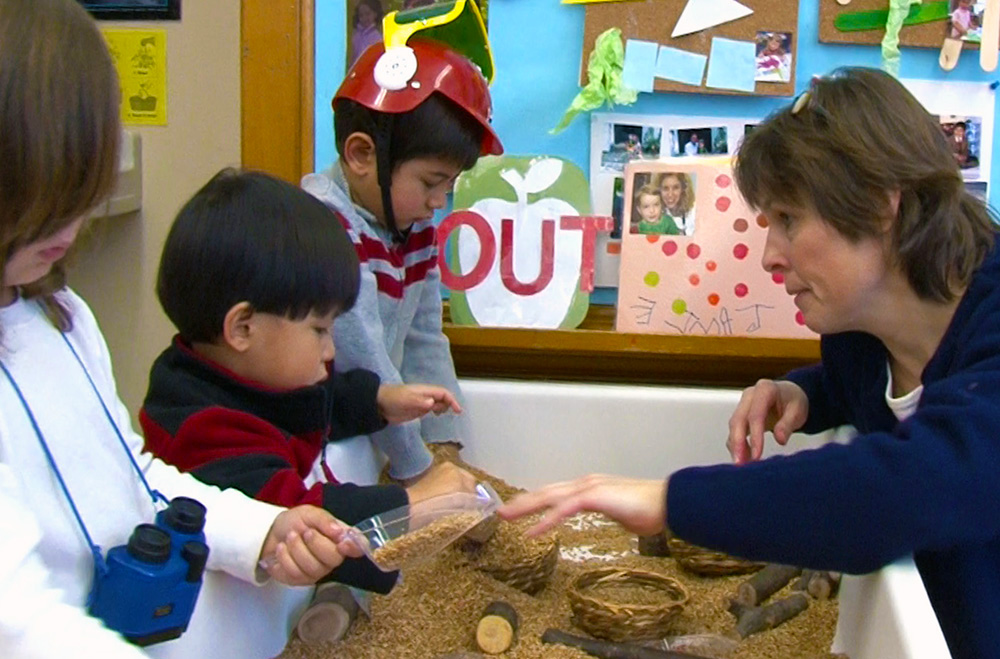重要的是提供各种室内机会,以支持儿童的身体发展。本课程描述了如何在促进发展的有意义的室内体验中聘请学龄前儿童。万博体育全站app
Secondary tabs
- 列出您可以在室内支持儿童体育发展的方式的示例。
- 探索提供有关支持教室中所有儿童的物理开发的信息的资源。
- List examples of accommodations you can use to support the physical development of children with special learning needs in your classroom.
Learn
知道
该preschool years are considered some of the most active times in an individual’s life. Considering what you learned in Lesson One (Physical Development: An Introduction) about the significance of physical activity in young children’s lives, it becomes clear that preschool children need time for movement and active play. Keeping in mind that language and social development also take place during active play, you want to make sure that in your daily work, you provide children with ample opportunities to meaningfully interact and connect with each other. While children are engaged in active play, you have numerous opportunities to observe them and gather valuable information about their development.
Your program should provide children with plenty of opportunities to engage in physical activity. Preschoolers should engage in physical activity, whether indoors or outdoors, for at least 60 minutes each day. Your program should strive to provide two hours for activities in which children are not sedentary, where they can choose vigorous physical activity or other play, such as dressing up in costumes. Though one hour of activity is recommended, this sixty-minute block may be broken down into increments of five-, 10-, 15-, or 20-minute periods throughout the day. Thirty minutes could be filled with structured activities like games, while another half-hour may consist of unstructured activities.
在课堂惯例中嵌入体力活动
身体活动不应被视为课堂常规的休息,但应该是其中的一部分!运动使儿童能够释放能源,因为他们练习现有技能并学习新的能源。让孩子们的毛细管和精细运动技能介绍,同时也考虑了对儿童整体发展的效益,考虑以下经验的例子,您可以在课堂上提供儿童:
- 在中心工作期间:
Provide children with opportunities to engage in pretend play in your dress-up area; use blocks or other items from nature to build or balance objects in the block area; draw or write using different materials in the art or writing center; explore and manipulate various items and textures in the discovery center; listen, watch the screen, or direct the mouse in a listening center or computer center; explore different textures, scents, colors, or sizes in a sensory center. - During circle time:
像西蒙这样的玩游戏说或遵循领导者让孩子们活跃。下载并打印附件Non-Competitive Active Games在本节中,提示一些传统游戏不竞争。这些游戏可以在室内或户外玩耍。对于一些这些游戏,如果您需要更多空间,您可能必须调整您房间的家具。 - 在故事时间或之后:
鼓励孩子扮演一个故事的部分或假装是故事角色并模仿他们的动作和声音。 - 在小吃或午餐时间:
鼓励孩子使用器具,练习试图打开容器,在桌子周围通过食物,服务,并在自己之后清理。 - 在过渡时间期间:
让孩子们走路,螃蟹,或跳到他们需要的地方,以确定他们是安全的。 - During any time:
戴上一些音乐,邀请孩子们去舞会。跳舞需要活跃,不断的运动。舞蹈涉及协调,灵活性和力量,并有助于增加学龄前儿童的议案范围(国家舞蹈教育组织,2011年)。万博体育全站app如果您需要制作更多空间,并鼓励孩子们提出关于最受欢迎的歌曲或音乐类型的建议,请调整您的房间内的家具。您还可以安排“锻炼时间”与儿童进行简单的练习。如果你包含音乐,这些练习可能更有趣。
With a little imagination and outside-the-box thinking, you can come up with numerous fun activities to keep children active throughout the day. For example, you can set up an indoor basketball game with crumpled up newspaper “balls” that children throw into a cardboard box or any type of basket, or you can ask children to “ice skate” wearing socks on a smooth floor. While making sure children are safe at all times, there are limitless possibilities to what you can do in your classroom!
支持ing The Physical Development of All Preschoolers
体力活动可能是经验和表达differently by children with developmental disabilities. For these children you may have to adapt your curriculum and environment, as well as your classroom activities to enable them to succeed. If you are working with children with special learning needs, think about how your existing practices are enabling them to succeed. Think about busy center work, transitions from one activity to another, lunch, naptime, potty time, free play time indoors and outdoors, as well as other school events. What are some things you are currently doing to support the physical development of all children in your care during the times mentioned above?
您护理中的一些儿童可能具有影响其运动发展的条件,包括身体和认知残疾,神经系统和感性障碍以及注意力缺陷/多动障碍。具有个性化教育计划的儿童(IEP)有一个具体的计划,以帮助他们满足个人目标和目标。通常,这些儿童将需要更改或适应课程,课堂环境和每日学龄前的活动。万博体育全站app有身体和其他发展障碍的儿童可能需要相关的服务,以确保他们充分访问他们的课堂和学校课程,活动,环境,课外活动和学校活动。
具有身体残疾的儿童可能具有困难的运动协调和肌肉力量。虽然有些孩子可能能够以最少或没有帮助的帮助,但其他儿童可能需要效力,但可能需要使用辅助技术。这可能包括设备,例如轮椅或括号,或使能够探索周围环境并与他人互动的通信设备。身体残疾的儿童也可能具有视觉,听证或智力障碍,这些损害需要在日常课堂活动方面使用重要的支持和住宿。您可能与肌肉色调低的儿童(导致平衡差),并且您必须支持他们的访问和参与电机活动。您可能会遇到有时可能非常活跃,冲动或更容易分散注意力的注意力缺陷/多动障碍的儿童,并且您必须支持他们的成功参与您的计划活动。
要创建一个更包容的环境并支持所有学习者,您必须承担一种包容性态度。您的设施符合美国残疾人法案(ADA),因此在最低儿童和家庭拥有各种身体需求的家庭可以访问您的建筑物。但是,您必须超越访问权限。确保所有儿童和家庭都感到欢迎和涉及。该孩子们在一起(套件)程序可以是思想的宝贵资源。你也可以考虑Building Blocksand卡拉的套件。这些资源委员会的例外Children Division for Early Childhood provide practical, real-world ways to help children succeed in their environments. When a child with identified special needs enters your program, work with the disability specialists Inclusion Action Team to make sure you and the staff members know how to support the child’s physical development. You can be a resource for brainstorming and for providing materials. Consider these quick and easy adaptations:
确定需要:
Child has a hard time gripping or catching a ball.可能的解决方案:
- Affix Velcro strips to the ball to make it easier to grasp
- Create your own ball out of crumpled paper wrapped in masking tape.
- 使用沙滩球。
- 用围巾投掷和捕捉。
确定需要:
孩子踢球。可能的解决方案:
- Slightly deflate the ball to make it easier to catch or kick.
- 使用较大的球。
- 在诸如草地或地毯等地面上播放,为球提供一些摩擦。
确定需要:
孩子很难看到球可能的解决方案:
- 购买或用钟声购买球,所以有视力障碍的儿童可以参加。
- Use brightly colored materials.
促进学龄前的感官发现和发展万博体育全站app
Most people are familiar with the five senses of sight, hearing, smell, touch, and taste. There are at least two more senses, named theproprioceptiveand thevestibular senses。在体内的肌肉或其他结缔组织中发现了丙肽感觉受体。它们被运动和重力刺激。这个感觉增加了身体意识并有助于电机控制。前庭感觉受体在内耳中发现。它们有助于确定任何运动的速度和方向。所有七种感官都是我们的身体响应外部刺激的方式。学龄前环万博体育全站app境可以帮助所有孩子培养他们的感官。本节将探讨帮助促进学龄前儿童感官发展的方法。万博体育全站app
Movement and exploration promote sensory development. Art and writing centers offer many opportunities for children to move and explore. Scribbles explore the sense of sight and many art materials engage multiple senses (Dodge, Colker, & Heroman, 2002). Stickers, cotton balls, pipe cleaners, and other art materials have varying colors, sizes, textures, and scents. Different sizes of paintbrushes and different painting tools, such as sponges and rollers, create different textures.
其他学习环境狗万app怎么下载接触多种感官。块和玩具有不同的纹理和颜色。计算机程序可以刺激许多感官。孩子们通过耳机听,观看屏幕,并引导鼠标。音乐和运动也使用多种感官。这包括听音乐,参与舞蹈或播放乐器。食品制备和烹饪允许学龄前儿童探索味道和其他感官。万博体育全站app
One piece of furniture or equipment that engages preschoolers’ sensory development is the sensory table. Sensory tables can be filled with many items. Children can explore by squishing, sorting, digging, pouring, and playing freely. The items can be rotated and changed on a regular basis. If you do not have a sensory table, you can use plastic boxes or other containers in a sensory center.

感官中心或桌子的想法:
- Water.
You can increase interest at the water table or center by adding food coloring or soap to the water. You can also decorate the bottom of the table or container with colored contact paper. Small toys can be added as well as fish, rocks, or items that sink and float to stimulate sensory and cognitive development.  砂。
砂。
This can be used with or without water. Adding small sifters, cups, funnels, and colorful rocks can add to the learning. 天然材料。
天然材料。
安全的季节性植物材料很容易处理。这包括树枝,污垢,叶子等。- 办公用品。
万博体育全站app学龄前儿童可以用切碎的纸张,包装花生或彩色纸夹。在玩小物体时务必监督儿童,例如包装花生和纸夹,这可能会窒息危险。 - 教室或家居用品。
Large beads and buttons, cotton balls, or kitchen utensils are items that children can explore.
When selecting materials for sensory activities, always consider the developmental needs of the children in your classroom. Establish rules for making safe choices at the sensory table or center. For example, “Sensory items stay in hands or in the table, not in mouths.” Other rules include limiting the number of people allowed at the center at one time. Adult supervision may also be required.
Preschoolers will use sensory centers to discover many concepts. Add tools or toys to vary sensory center activities. Use tongs to pick up small toys to help children strengthen fine motor skills. Sorting items by color or by attributes, like sinking and floating, introduces sorting and science concepts. Watch the second video in the Learn section of this lesson to discover how one classroom explored ice.
See
What does indoor physical activity look like in preschool? What can you do to support preschool children’s physical development indoors? What experiences and materials support physical development? There are many answers to these questions. Take a look at these videos to learn more and to see examples.
Indoor Environments and Experiences
Exploring Ice
做
Try some of these ideas to help actively include all children in your classroom activities. Remember that your role is to give each child what he or she needs to be successful when necessary. Remember also that at some point, all children in your classroom will need extra help and support. Above all, get to know the children in your care well and collaborate with other individuals who know them, such as family members, therapists, or related services personnel.
Experiences and Materials
- Think safety first!
- Plan activities after considering children’s particular needs and making sureallchildren in your classroom have access to spaces and materials.
- While planning for activities, consider tasks that may be difficult for particular children (e.g., stringing beads) and be ready to help these children complete these tasks or ask children to work together and to help each other.
- 确保您的材料适合儿童。
- Be open-minded and think outside the box! Provide sensory-stimulating activities and materials that allow children to use multiple senses in order to learn by seeing, touching, smelling, tasting, or hearing. Some children may be particularly sensitive or responsive to different kinds of stimuli or materials, and as a preschool teacher, it is important that you are willing to explore other options.
Classroom Environment
- 让您在课堂上轻松移动。
- Make changes in your classroom environment. A quiet area for play with a smaller number of materials may help an overactive child be more successful because it presents fewer choices in terms of materials or toys.
- 对可能对噪声,光或触摸敏感的儿童的材料,活动或环境进行适应。您中心的其他灯光可能对具有愿景挑战的儿童有所帮助。
Classroom Interactions
- Observe children playing and make sure that all children are included in activities.
- Model appropriate behaviors and show children how they can invite and include others in their play.
- 当他们在他们的戏或活动中包括其他孩子时赞美孩子。
- 为儿童与同行合作提供机会,因此他们可以相互学习,同时也练习社交技能。
考虑多个观点
- Get input from children’s families, related professionals who work with them, or the children themselves about things that work or don’t work.
- Help all children be independent by asking them to make choices and encouraging them to do things by themselves for themselves. At the same time, be sensitive to families’ wishes and beliefs that may reflect values that are different from your own (for example, valuing interdependence and relationship-building versus independence from a young age).
探索
您目前在课堂兴趣区提供什么机会,以便儿童参与促进其体育发展的室内体验?下载并打印Reflecting On My Classroom Practice Activity。For each box, list or describe experiences and materials you provide. Then jot down ideas about additional experiences or materials you can incorporate to improve your practice. Share your responses with a co-teacher, coach, trainer, or supervisor.
Demonstrate
American Academy Of Pediatrics, American Public Health Association, National Resource Center for Health and Safety in Child Care and Early Education. (2011).Caring for Our Children: National health and safety performance standards; Guidelines for early care and education programs.(3rd ed.)。伊利安尔州麋鹿格罗夫村:美国儿科学院;华盛顿特区:美国公共卫生协会。从...获得http://nrckids.org.
做dge, D. T., Colker, L. J., & Heroman, C. (2002).该Creative Curriculum for Preschool(4th ed.). Washington, DC: Teaching Strategies.
Head Start Center for Inclusion. Retrieved fromhttp://headstartinclusion.org/
Head Start National Center on Quality Teaching and Learning. (2013). Adaptations for Individual Children: Adaptations for Children with Disabilities.
Lynch,S.&Simpson,C.(2004)。感官处理:使用七种感官满足个人需求。年轻的特殊孩子,7(4): 2-9.
播放。(2020)。游戏库。奥克兰,加利福尼亚州:Sports4kids。从...获得https://www.playworks.org/game-library/
全国体育与体育协会。(2009)。Active Start: A statement of physical activity guidelines for children from birth to age 5。( Second ed.). Retrieved fromhttps://www.shapeamerica.org/standards/guidelines/activestart.aspx
National Dance Education Organization (n.d.) Standards for Dance in Early Childhood. Retrieved fromhttps://www.ndeo.org/content.aspx?page_id=22&club_id=893257&Module_id=55419
Trawick-Smith,J.(2014)。Early Childhood Development: A Multicultural Perspective。Upper Saddle River, NJ: Pearson Education.
Turnbull, R., Turnbull, A., Shank, M., & Smith, S. J. (2004).Exceptional Lives: Specialeducation in today’s schools。Upper Saddle River, NJ: Pearson Education.



 砂。
砂。 天然材料。
天然材料。
